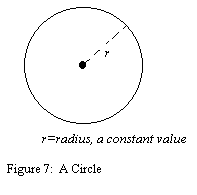Circles
| Philosophy of Mathematics |
While creating a resource page, please click here for a resource creation checklist.
Concept Map
Error: Mind Map file circle.mm not found
Textbook
ncert books
Class 9 Mathematics contain simple description and theorems on circles. 9 Mathematics contain higher level description and theorems on circles.
Additional Information
Useful websites
- maths is fun A GOOD WEBSITE ON DEFINITIONS FOR CIRCLES
- COOL MATH GIVES CLEAR AND EASY DEFINITIONS
- OPEN REFERENCE CONTAINS FEW SIMULATIONS
- WIKIPEDIA CONTAINS EXPLANATIONS FOR CIRCLES
- KHAN ACADEMY CONTAIN GOOD VIDEOS
- ARVIND GUPTA TOYS CONTAIN VERY GOOD BOOKS ON MATHEMATICS AND SCIENCE
- nrich.maths.org Contain very good description of Pie
Reference Books
- School Geometry By Hall and Stevens. Part3 pageno 143. Contains basic definitions and proofs given by Euclid.
Teaching Outlines
Introduction
Welcome to the world of fascinating polygons, the CIRCLES. The following is a background literature for teachers. It summarises the concepts to be known for a teacher to teach this topic more effectively . This literature is meant to be a ready reference for the teacher to develop the concepts, inculcate necessary skills and impart knowledge in Geometry - Circles from Class 6 to Class 10.
Starting from the primary class, the students are exposed to circles with examples to the class 12th analytic treatment of the same.
The pages here are designed to acquaint the teacher with basic definitions of circles from the 9th class to 10 standard.
Concept #1 CIRCLE
Learning objectives
Definition:A circle is a collection of all points in a plane, which are equidistant from a fixed point.

`http://lasp.colorado.edu/~bagenal/MATH/images/math3fig/circle.gif`
Activity No #1 Circle of varying radius using Geogebra
- Estimated Time: 20 mins
- Materials/ Resources needed: Laptop, geogebra,projector and a pointer
- Prerequisites/Instructions, if any:
- The students should know a circle
- They should know the meaning of radius .
- They should know to measure radius using compass
- They should know to draw a circle of given radius using compass.
- Multimedia resources: Laptop
- Website interactives/ links/ / Geogebra Applets:
- Process/ Developmental Questions:
- Review the terms plane closed figures, circle and radius.
- Show them how to measure radius on the compass
- Show them to draw a circle.
- Project the geogebra and let them view the changing size of the circle with changing radius.
- What is a circle ?
- Which point is the centre of the circle ?
- What is the radius of this circle ?
- How do you name the radius ?
- Evaluation:
- By what parameter is the size of a circle defined ?
- Bigger the radius, _____________ is the size of the circle.
- Question Corner:
- How do you name a circle ?
- Can you draw a circle without knowing the radius ?
Activity No #
- Estimated Time
- Materials/ Resources needed
- Prerequisites/Instructions, if any
- Multimedia resources
- Website interactives/ links/ / Geogebra Applets
- Process/ Developmental Questions
- Evaluation
- Question Corner
Concept # Is circle a Polygon ?
Learning objectives
Notes for teachers
Activity No #
- Estimated Time: 40 minutes
*Materials/ Resources needed
Laptop, geogebra file, projector and a pointer.
- Prerequisites/Instructions, if any
- The students should know that the plane figures with 3 or more than 3 sides are called polygons.
- They should know that as the number of sides increases, the figure and hence its name also changes.
- They should know the basics of a circle.
*Multimedia resources Laptop
- Website interactives/ links/ / Geogebra Applets
- Process
- Ask the students what polygons are ?
- As you increase the number of sides ask them to count the number of sides.
- Ask them the name of the shape formed.
- As the number of sides increase,let them speak about the length of the sides ?
*Developmental Questions
- How many sides does this figure have ?
- Name the figure formed.
- What is hapenning to the length of the sides as the number of sides is increased ?
- What shape is this ?
- So, can circle be considered a polygon ? Justify
- Evaluation:
- Are the students able to comprehend that the number of sides is getting infinite as the shape resembles a circle ?
- Are the students able to appreciate the application of polygon anology to circles.
- Question Corner
Debate between two groups with these two perspectives.
- Circle seems to have derived from polygons . Circle can be considered a polygon.
Vs
- A polygon is defined by a certain number of sides having non zero length. Then how can circle be a polygon ? (hint: all radii in a circle should be equal ???)
Activity No #
- Estimated Time
- Materials/ Resources needed
- Prerequisites/Instructions, if any
- Multimedia resources
- Website interactives/ links/ / Geogebra Applets
- Process/ Developmental Questions
- Evaluation
- Question Corner
Hints for difficult problems
Project Ideas
Math Fun
Usage
Create a new page and type {{subst:Math-Content}} to use this template